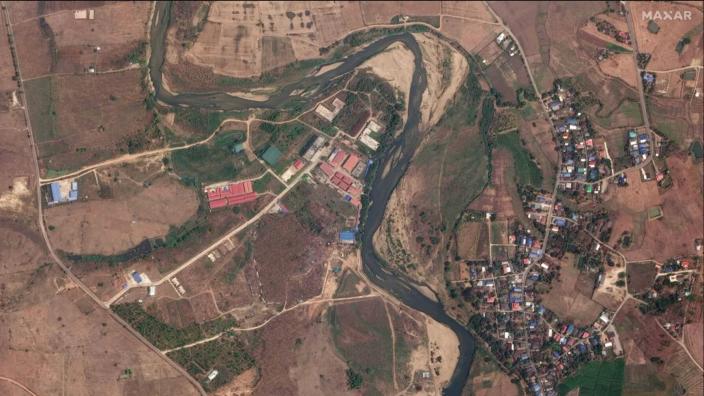Satellites spy on human trafficking ‘compounds’ (photo)

The International Justice Mission (IJM) says a partnership with the space technology company Maxar is allowing it to track the growth of “compounds,” places where people are forced to work as online scammers in Southeast Asia. The IJM publicized this effort in a tweet that featured three years of imagery captured by Maxar Earth-observing satellites.
Border towns in Myanmar like Shwe Kokko and Lay Kay Kaw, for example, “host gambling and entertainment complexes developed by Chinese investors” accused of human rights violations, according to the Financial Post.
“People from other nations are tricked into taking jobs and then put into virtual captivity and forced to work in call centers conducting internet scams,” the Post wrote in June of the accusations levied.
Related: Actor George Clooney using satellites as sentinels of Sudanese rights
The United Nations has tracked at least 225,000 human trafficking victims around the world in the past 20 years. Among the most vulnerable are women and those living in areas in conflict, according to the UN.
According to Reuters, the rise of human trafficking was the centerpiece discussion of the summit of the Association of Southeast Asian Nations (ASEAN) on May 10, during which leaders in the region pledged action on the issue.
Thousands of individuals confined in such operations have been “lured by social media posts promising well-paid jobs in countries like Cambodia, Laos and Myanmar,” Reuters reported.
RELATED STORIES:
— Satellites are critical to fighting the climate crisis, scientists say
— Satellites watch floods ravage Ukraine following dam collapse (photos)
— First responders in space: How satellites save lives during natural disasters
ASEAN's statement said that technology, though an “indispensable element” of human lives around the world, has “generated risks and consequences of technology abuse, in facilitating transnational and organized criminal activities.”
No country is immune from trafficking, but Southeast Asia is said by experts to have an inordinate number of victims. ASEAN thus pledges to work regionally to find victims or potential victims, as well as to take into account factors that affect vulnerability such as “gender, ethnicity, disability, age” — not to mention poverty.
Aside from examining compounds from orbit, human trafficking can also be detected by other satellite means. Data from satellites operated by the San Francisco-based company Planet, for example, is used by Stanford University's Human Trafficking Data Lab to seek out “forced labor” in deforested areas of Brazil's Amazon rainforest.
Stanford officials stated in 2022 that they hope to develop an algorithm that would alert investigators to sites actively being used; increased charcoal is often a telltale sign of deforestation underway, for example. Quick action may increase enforcement while more easily rescuing victims.
This “Eyes on Trafficking” story is reprinted from its original online location.
Fair Use Notice: The PBJ Learning Knowledge Vault is dedicated to advancing understanding of various social justice issues, including human trafficking and related topics. Some of the material presented on this website may contain copyrighted material, the use of which has not always been specifically authorized by the copyright owner. We are making such material available in our efforts to promote education and awareness of these important issues. There is no other central database we are aware of, so we put this together for both historical and research purposes. Articles are categorized and tagged for ease of use. We believe that this constitutes a ‘fair use' of any such copyrighted material as provided for in section 107 of the US Copyright Law. In accordance with Title 17 U.S.C. Section 107, the material on this site is distributed without profit to those who have expressed a prior interest in receiving the included information for research and educational purposes. For more information on fair use, please visit: “17 U.S. Code § 107 – Limitations on exclusive rights” on Cornell Law School's Legal Information Institute.
 ABOUT PBJ LEARNING
ABOUT PBJ LEARNING
PBJ Learning is a leading provider of online human trafficking training, focusing on awareness and prevention education. Their interactive Human Trafficking Essentials online course is used worldwide to educate professionals and individuals how to recognize human trafficking and how to respond to potential victims. Learn on any web browser (even your mobile phone) at any time.
More stories like this can be found in your PBJ Learning Knowledge Vault.
EYES ON TRAFFICKING
This “Eyes on Trafficking” story is reprinted from its original online location.
ABOUT PBJ LEARNING
PBJ Learning is a leading provider of online human trafficking training, focusing on awareness and prevention education. Their interactive Human Trafficking Essentials online course is used worldwide to educate professionals and individuals how to recognize human trafficking and how to respond to potential victims. Learn on any web browser (even your mobile phone) at any time.
More stories like this can be found in your PBJ Learning Knowledge Vault.
